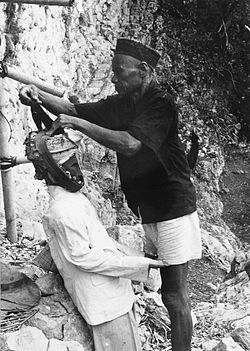
Summary
Tau tau are a type of effigy made of wood or bamboo. They are particular to the Toraja ethnic group in South Sulawesi, Indonesia. The word "tau" means "man", and "tau tau" means "men" or "statue".[1]



Tau tau are believed to have originated in the 19th century. They were once produced only for the wealthy, to reflect the status and wealth of the deceased.[2] The tau tau are representatives of the deceased, ever-guarding the tombs and ever-protecting the living.[citation needed]
History edit
In the early 1900s, with the arrival of the Dutch Christian missionaries in Toraja, the production of tau tau was somewhat dampened. At the 1985 synod of Toraja Church in Palopo people debated if Protestant Toraja could have tau tau at their funerals.[3]
Torajans believe that the dead can take their possessions with them to the after life, the effigies are usually equipped with small possessions. In 1980s, the wooden effigies became a target for grave robbers looted and possessions kept with them and sold the figures to museums. Tau tau can now be found in Jakarta, Europe and America, and were once even on display at the Smithsonian Institution in 1991.[4] In response to this plunder of the ancestors, the Torajans hid their tau tau in various undisclosed locations. They also installed metal fences surrounding their cave graves to protect the tau tau. It is somewhat ironic that the tau tau is meant to represent the deceased protecting the living, but they now have to be protected against the living.[5]
Traditionally, the effigies were simply carved, only to show the gender of the deceased. However, they have become more and more elaborate, actually attempting to imitate the likeness of the deceased. Nowadays, tau tau have photographic likeness to the people they represent. They are carved with wrinkles and carry items like Bibles.[3]
The types of wood used for the effigies and what they are clothed in also reflect the status and wealth of the deceased. Tau tau of the wealthy would generally be made of wood from the jackfruit tree. They are usually permanent statues that can be found standing at the entrance of tombs, which are carved out of rock faces of Toraja. Their position, in reference to the other tau tau, in the rock face would indicate the status of the deceased. The cave builders usually require payment of several buffalos that only the sufficiently wealthy can afford.[1] The less wealthy elites generally have their tau tau made from bamboo, which will be undressed at the end of the funeral, leaving only the bamboo on the ritual field. There are regional variations in the types of tau tau used, also.
See also edit
References edit
- ^ a b Blanche, Patrick. "The tau tau of the Toraja". Raw Vision. Watford, Hertfordshire. Retrieved 30 January 2011.
- ^ Sammut, Jesmond (23 October 2009). "Tau tau gallery at Toraja burial site". The Australian Museum. Retrieved 30 January 2011.
- ^ a b Adams, Kathleen M. 2006 Art as Politics: Re-crafting Identities, Tourism and Power in Tana Toraja, Indonesia. Honolulu: University of Hawaii Press. http://www.uhpress.hawaii.edu/p-9780824830724.aspx
- ^ Volkman, Toby Alice (February 1990). "Visions and Revisions: Toraja Culture and the Tourist Gaze". American Ethnologist. 17 (1): 91–110. doi:10.1525/ae.1990.17.1.02a00060. JSTOR 645254.
- ^ Adams, Kathleen M. (1993). "Theologians. Tourists. and Thieves: The Torajan Effigy of the Dead in Modernizing Indonesia". Kyoto Journal. 22: 38–46.


